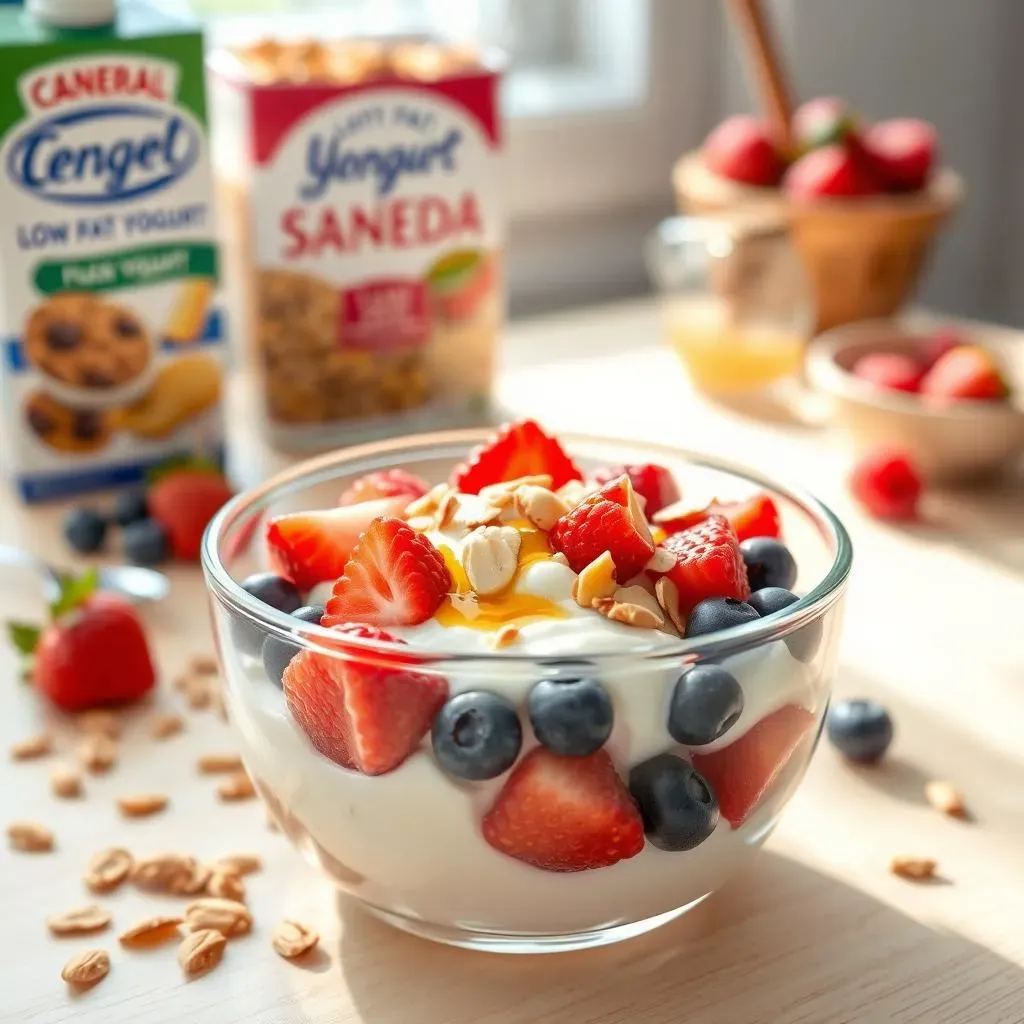Table of Contents
Navigating the yogurt aisle can feel like decoding a secret language. Low-fat, non-fat, Greek, Icelandic, plant-based – the options are endless. If you're on a quest for a healthier lifestyle or trying to manage your weight, you're probably wondering: what is a good low fat yogurt? This guide cuts through the confusion, offering a clear path to making the best choice for your needs. We'll explore the health benefits of low-fat yogurt, highlight top brands and varieties that dietitians recommend, and provide practical tips on how to seamlessly integrate this nutritional powerhouse into your daily diet. Whether you're seeking a protein-packed breakfast, a guilt-free snack, or a versatile ingredient for your favorite recipes, we've got you covered. Get ready to discover the delicious and nutritious world of low-fat yogurt and learn how to make informed decisions that support your health goals. We will give you the best low-fat yogurt options to help you achieve the healthier life you deserve!
Understanding LowFat Yogurt: What to Look For

Understanding LowFat Yogurt: What to Look For
Decoding the Label: Fat Content and Calories
So, you're staring down a wall of yogurt cups, trying to figure out which one is actually "low-fat." It's not as simple as grabbing anything that says "light" or "diet." The FDA has specific guidelines: low-fat yogurt must have 3 grams of fat or less per serving. Pay close attention to the serving size, because some brands cleverly list nutritional info for a smaller portion than you'd actually eat. And don't just focus on fat; check the calorie count too. Sometimes, manufacturers compensate for the lack of fat by adding extra sugar, which defeats the purpose if you're aiming for a healthy snack.
Consider this: a yogurt boasting "0% fat" might sound ideal, but if it's loaded with added sugars, it could be worse for your overall health than a slightly higher-fat option with less sugar. It's all about balance and reading those labels carefully.
The Protein Factor: Why It Matters
Beyond fat and calories, protein is a key player when choosing a low-fat yogurt. Protein helps you feel fuller for longer, which can be a game-changer if you're trying to manage your weight or avoid those mid-afternoon cravings. Greek and Icelandic yogurts (like Skyr) are typically packed with protein, often containing double or even triple the amount found in regular yogurt. This makes them a fantastic choice for breakfast or a post-workout snack.
But remember, not all Greek yogurts are created equal. Some brands add cream or other ingredients to achieve a richer texture, which can increase the fat content. Always double-check the label to ensure you're still within the low-fat range. Look for options with at least 10 grams of protein per serving for maximum satiety.
Added Sugars: The Sneaky Culprit
Here's where things get tricky. Many low-fat yogurts are loaded with added sugars to improve their taste and texture. This is especially common in flavored varieties, like strawberry, vanilla, or key lime pie (yes, really!). These added sugars can quickly add up, negating the health benefits of the low-fat content. Excess sugar consumption can lead to weight gain, blood sugar spikes, and other health problems.
The best approach is to opt for plain, unsweetened low-fat yogurt and add your own natural sweeteners, like fresh fruit, a drizzle of honey, or a sprinkle of cinnamon. This way, you have complete control over the sugar content. If you prefer flavored yogurt, look for options that are sweetened with stevia, erythritol, or other sugar substitutes – but be mindful of artificial ingredients and potential digestive issues.
Yogurt Type | Fat Content (per serving) | Protein Content (per serving) | Typical Added Sugars (per serving) |
|---|---|---|---|
Plain Low-Fat Yogurt | 0-3g | 10-20g | 0-5g |
Flavored Low-Fat Yogurt | 0-3g | 5-10g | 15-30g |
Greek Low-Fat Yogurt | 0-3g | 15-25g | 0-10g |
Health Benefits of LowFat Yogurt

Health Benefits of LowFat Yogurt
so you've picked out your perfect low-fat yogurt – now what? Let's dive into why this stuff is actually good for you. First off, it's a fantastic source of calcium, which is crucial for strong bones and teeth. Think of it as insurance against future fractures. But the benefits don't stop there. Low-fat yogurt is also packed with protein, which, as we discussed earlier, keeps you feeling full and helps maintain muscle mass. And speaking of muscles, the protein in yogurt contains essential amino acids that your body can't produce on its own. These amino acids are vital for repairing tissues and supporting overall bodily functions. Beyond the macros, low-fat yogurt often contains probiotics, those friendly bacteria that support a healthy gut. A balanced gut microbiome is linked to improved digestion, a stronger immune system, and even better mental health. So, you're not just eating yogurt; you're feeding your gut a happy little army of beneficial bugs!
What is a Good LowFat Yogurt? Top Brands and Varieties

What is a Good LowFat Yogurt? Top Brands and Varieties
Greek Yogurt Powerhouses
When it comes to protein and versatility, Greek yogurt reigns supreme. Chobani and Fage are two titans in this category, offering a range of low-fat and non-fat options. Chobani's Less Sugar Greek Yogurt is a great pick if you're watching your sugar intake, while Fage Total 0% is a classic, no-frills choice that's incredibly thick and creamy. Both brands are widely available and can be used in countless recipes, from smoothies to dips.
But don't overlook smaller brands! Look for local dairies or specialty yogurt makers in your area. They often use higher-quality milk and traditional methods, resulting in a yogurt with a richer flavor and texture. Plus, you'll be supporting local businesses!
Icelandic Skyr Sensations
If you're after even more protein, Icelandic Skyr is your go-to. Siggi's and Icelandic Provisions are two popular brands that specialize in Skyr. Siggi's Skyr is known for its simple ingredients and low sugar content, while Icelandic Provisions offers a variety of unique flavors inspired by Icelandic cuisine. Skyr is incredibly thick and dense, making it a satisfying and filling snack.
Skyr is traditionally made by straining away the whey, resulting in a yogurt that's lower in lactose and higher in protein than Greek yogurt. This makes it a good option for people who are sensitive to lactose or who need a protein boost. Just be aware that Skyr can be a bit pricier than Greek yogurt.
Plant-Based Yogurt Alternatives
For those who are dairy-free or vegan, there are plenty of delicious plant-based yogurt alternatives to choose from. Brands like So Delicious, Silk, and Oatly offer yogurts made from soy, almond, coconut, and oat milk. These yogurts can be a good source of protein, calcium, and vitamin D, but it's important to check the labels carefully for added sugars and unhealthy fats.
Soy yogurt is often the highest in protein, while coconut yogurt tends to be the richest and creamiest. Oat yogurt is a good option if you're looking for a neutral flavor and a smooth texture. Experiment with different brands and varieties to find the one that suits your taste and dietary needs.
Yogurt Type | Brand Examples | Key Features |
|---|---|---|
Greek Low-Fat | Chobani, Fage | High protein, versatile |
Icelandic Skyr | Siggi's, Icelandic Provisions | Very high protein, thick |
Plant-Based (Soy) | Silk, So Delicious | Dairy-free, good protein |
Plant-Based (Oat) | Oatly | Dairy-free, smooth texture |
How to Incorporate LowFat Yogurt into Your Diet

How to Incorporate LowFat Yogurt into Your Diet
Breakfast Boost: Starting Your Day Right
One of the easiest ways to incorporate low-fat yogurt into your diet is by making it a breakfast staple. Swap out sugary cereals or pastries for a bowl of plain low-fat Greek yogurt topped with fresh berries, a sprinkle of nuts, and a drizzle of honey. This provides a satisfying combination of protein, fiber, and healthy fats that will keep you feeling full and energized until lunchtime. You can also blend low-fat yogurt into smoothies for a quick and nutritious breakfast on the go. Add fruits, vegetables, and a scoop of protein powder for an extra boost.
Don't be afraid to get creative! Try layering low-fat yogurt with granola and fruit in a parfait, or using it as a base for overnight oats. The possibilities are endless, and you can easily customize your breakfast to suit your taste and dietary needs. For a warm and comforting option, try baking low-fat yogurt into muffins or scones. Just be sure to adjust the recipe to account for the added moisture.
Snack Attack: Curbing Cravings the Healthy Way
Low-fat yogurt makes an excellent snack between meals, helping you to avoid unhealthy cravings and keep your energy levels stable. A small container of plain low-fat yogurt with a handful of almonds or a few slices of apple is a simple and satisfying snack that's packed with protein and nutrients. You can also use low-fat yogurt as a dip for vegetables like carrots, celery, and cucumbers. Add some herbs and spices for extra flavor.
For a sweeter treat, try freezing low-fat yogurt in popsicle molds with chunks of fruit. This is a refreshing and healthy alternative to store-bought ice cream. Another option is to make yogurt bark by spreading a thin layer of low-fat yogurt on a baking sheet, topping it with berries and nuts, and freezing it until solid. Break it into pieces and enjoy as a guilt-free dessert.
Snack Idea | Ingredients | Benefits |
|---|---|---|
Yogurt with Almonds | Low-fat yogurt, almonds | Protein, healthy fats |
Yogurt Dip with Veggies | Low-fat yogurt, herbs, spices, vegetables | Low-calorie, nutrient-rich |
Frozen Yogurt Pops | Low-fat yogurt, fruit | Refreshing, healthy dessert |
Culinary Creations: Cooking and Baking with Yogurt
Low-fat yogurt isn't just for breakfast and snacks – it can also be a versatile ingredient in cooking and baking. Use it as a substitute for sour cream or mayonnaise in dips, dressings, and sauces to reduce the fat content without sacrificing flavor. Low-fat yogurt can also be used to tenderize meat, add moisture to baked goods, and create creamy soups and stews.
In Indian cuisine, yogurt is a key ingredient in marinades for tandoori dishes and in cooling raitas. In Middle Eastern cuisine, it's used to make creamy labneh and tangy sauces. Experiment with different cuisines and recipes to discover the many ways you can incorporate low-fat yogurt into your meals. Just be sure to avoid boiling yogurt directly, as it can curdle. Instead, add it at the end of cooking or temper it with a little bit of the hot liquid before adding it to the pot.
Making the Right Choice: What is a Good LowFat Yogurt for You?

Making the Right Choice: What is a Good LowFat Yogurt for You?
Know Thyself: Defining Your Priorities
Alright, so we've covered the basics – fat content, protein, added sugars, brands, and ways to eat it. But ultimately, the "best" low-fat yogurt is the one that fits *your* lifestyle, taste preferences, and health goals. Are you primarily concerned with weight management? Then prioritize high-protein, low-sugar options. Are you an athlete looking to recover after a workout? Focus on yogurts with a good balance of protein and carbohydrates. Do you have dietary restrictions or allergies? Explore the world of plant-based yogurts. There's no one-size-fits-all answer here.
Think about your daily routine. Do you need a quick and easy breakfast that you can grab on the go? Or do you have time to create a more elaborate yogurt parfait? What flavors do you enjoy? Are you a purist who prefers plain yogurt, or do you crave something sweeter and more indulgent? Answering these questions will help you narrow down your options and find the perfect low-fat yogurt for you.
Experiment and Explore: The Fun Part
Don't be afraid to try different brands and varieties of low-fat yogurt until you find the ones you love. Read reviews online, ask friends for recommendations, and take advantage of sample opportunities at your local grocery store. Pay attention to the texture, flavor, and overall mouthfeel of each yogurt. Does it taste artificial or natural? Is it too tart or too sweet? Does it leave a strange aftertaste?
Consider this your yogurt adventure! Maybe you'll discover a hidden gem at a local farmers market, or maybe you'll stick with a tried-and-true favorite from a national brand. The most important thing is to find a low-fat yogurt that you genuinely enjoy eating, so that you're more likely to make it a regular part of your diet. And remember, taste is subjective – what one person loves, another might hate. So, trust your own palate and don't be afraid to experiment!
Priority | Yogurt Characteristics | Example Options |
|---|---|---|
Weight Management | High protein, low sugar | Plain Greek yogurt, Siggi's Skyr |
Post-Workout Recovery | Balanced protein/carbs | Low-fat yogurt with fruit |
Dairy-Free | Plant-based (soy, almond, oat) | So Delicious, Oatly |
Conclusion: Your Guide to Choosing the Best Low-Fat Yogurt
Ultimately, the "best" low-fat yogurt is the one that aligns with your individual taste preferences, dietary needs, and health objectives. Armed with the knowledge of what to look for – high protein, low added sugars, and minimal saturated fat – you can confidently navigate the yogurt aisle and select options that support your wellness journey. Whether you opt for a classic Greek yogurt, a creamy Icelandic skyr, or a plant-based alternative, remember that incorporating low-fat yogurt into a balanced diet can contribute to improved gut health, weight management, and overall well-being. Experiment with different brands, flavors, and toppings to discover your personal favorites and enjoy the delicious and nutritious benefits that low-fat yogurt has to offer.
